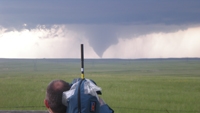Weather Channel photographer uses Petrol Raincover for shooting tornados

When it comes to camcorder rain cover users, there are those who shoot in the rain and then there’s Richard Campbell, who has shot video in 25 named hurricanes and spent five weeks on assignment for The Weather Channel with a tornado researching crew.
A freelance news photographer, Campbell’s assignment had him embedded with a National Oceanic and Atmospheric Administration (NOAA) and National Science Foundation (NSF) mobile crew. This group of scientists, with weather instrument-equipped vehicles, roamed the southern and central plains from mid-May through mid-June to understand how, when and why tornadoes form. His live video from the resultant tornado observations was seen on The Weather Channel during this period.
When working in hurricane conditions, the camera operator is in serious driving rain and wind. It is the ultimate test of camera rain cover protection. Campbell used the Petrol PRC-25 Raincover to protect his HPX-2000 camcorder from elements coming from all directions.
Petrol’s extensive use of zippers rather than Velcro material to fasten the raincover was a major advantage, Campbell found. Velcro works loose during rainy, windy conditions and can fail, allowing the cover to be blown off the camera.
Another benefit of the Petrol raincover is the hot shoe connector at the rigid front hood section. Most traditional covers have to be opened to access the camcorder’s hot shoe when attaching an on-camera light. The connector features a ¼-20 threaded bolt that is accessible through a waterproof opening at the top of the PRC-25, a major advantage when needing a light in rainy conditions.
Access to the camcorder’s eyepiece is another strength of Petrol’s design. All the Velcro around the viewfinder has been eliminated and replaced with a zipper, making it much easier to get that on and off. Battery packs and wireless microwave transmitter are much easier to change using the zipper system.
The professional video industry's #1 source for news, trends and product and tech information. Sign up below.
